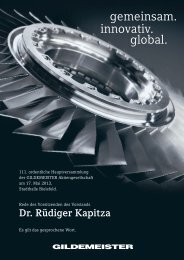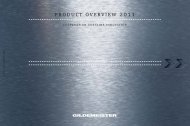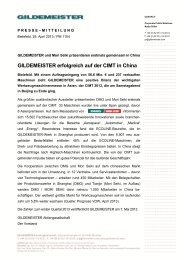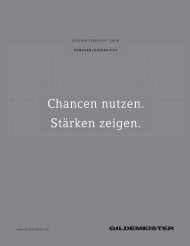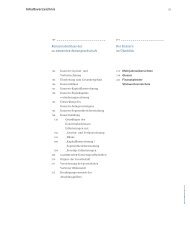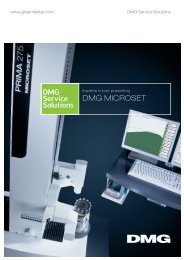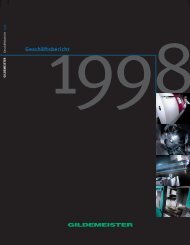PDF (7.3 MB) - GILDEMEISTER Interim Report 3rd Quarter 2012
PDF (7.3 MB) - GILDEMEISTER Interim Report 3rd Quarter 2012
PDF (7.3 MB) - GILDEMEISTER Interim Report 3rd Quarter 2012
- No tags were found...
You also want an ePaper? Increase the reach of your titles
YUMPU automatically turns print PDFs into web optimized ePapers that Google loves.
18Business Environment: Overall Economic Development / Development of the Machine Tool Industrybusiness reportBusiness EnvironmentThe us dollar, the Chinese yuan and the Japanese yen are of particular importance forgildemeister’s international business. The exchange rate of the currencies most importantfor us changed over the course of 2010 as follows: The currencies important for gildemeistergained in value compared to the euro over the course of 2010. The us dollarclosed at year-end against the euro at 0.75 euros (previous year: 0.69 euros). The Chineseyuan likewise gained in value compared to the euro, at year-end the exchange rate was8.82 yuan (previous year: 9.84 yuan). The Japanese yen closed against the euro at arate of 108.65 yen (previous year: 133.16 yen). On average, all three currencies gainedin value over the year against the euro. The us dollar recorded a gain in value of about5.0%, the yuan of 5.8% and the Japanese yen of 10.8%. Our products have thus becomeincreasingly more competitive in both the dollar region and the Asian region.Development of the Machine Tool IndustryInternational developmentThe world market for machine tools once again developed positively in 2010 – based ona weak comparison basis. The German Machine Tool Builders Association (vdw) calculatedgrowth in global consumption of 25% or € 8.9 billion to € 45.0 billion (previous year:€ 36.1 billion). The industry thus finds itself once again above the level of the year 2005.Development of global consumption in a 10-year comparison is presented in the“Forecast report” chapter on page 113.The global machine tool market is marked by an enormous structural shift towardsAsia, more especially towards China. Asia’s share in global consumption amounted tojust under 62%. America and Europe have clearly lost global market share in the lastten years. Asia is leading the global recovery process; demand has continued to showdynamic growth (+25%). Once again, by a clear margin, most machine tools worldwidewere purchased in China at € 15.9 billion and a share in world consumption of 35%.China is once again the largest sales market worldwide (previous year: 30%). In Americaconsumption has risen (+18%). In Europe the trend was still slightly downwards (–3%).Germany lies in second place at € 3.7 billion (change to the previous year: –11%) and aglobal consumption share of 8%. It is followed by South Korea (consumption: € 3.2 billion;change to the previous year: +67%; global consumption share: 7%) and Japan(€ 2.9 billion; +24%; 6%). Places five to ten were taken by the usa (€ 2.3 billion; –3%;5%), Italy (€ 2.2 billion; +7%; 5%), Brazil (€ 1.3 billion; +25%; 3%), India (€ 1.2 billion;+33%; 3%), Taiwan (€ 1.2 billion; +82%; 3%) and Russia (€ 0.9 billion; –2%; 2%).The ten most important consumer markets represent 77% of the total global consumptionof machine tools (previous year: 76%).



